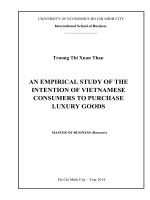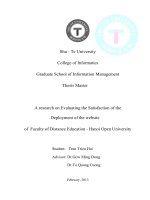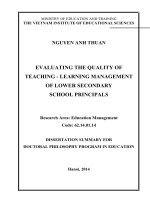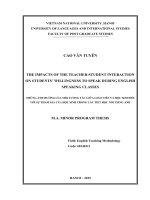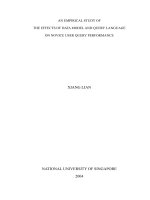EVALUATING THE IMPACTS OF AUCTION BIDDING RESTRICTIONS ON CONSUMER SURPLUS AND BEHAVIORS AN EMPIRICAL STUDY OF ONLINE PENNY AUCTIONS
Bạn đang xem bản rút gọn của tài liệu. Xem và tải ngay bản đầy đủ của tài liệu tại đây (2.2 MB, 103 trang )
EVALUATING THE IMPACTS OF
AUCTION BIDDING RESTRICTIONS ON
CONSUMER SURPLUS AND BEHAVIORS
— AN EMPIRICAL STUDY OF
ONLINE PENNY AUCTIONS
ZHENG HANXIONG
(B.Sc., Sun Yat-Sen University)
A THESIS SUBMITTED
FOR THE DEGREE OF MASTER OF SCIENCE
DEPARTMENT OF INFORMATION SYSTEMS
NATIONAL UNIVERSITY OF SINGAPORE
2011
Acknowledgements
Acknowledgements
I would like to express my deep and sincere gratitude to my supervisors, Dr. Huang Kewei and Dr. Goh Khim Yong, for their insightful comments, splendid ideas and excellent
advices during the process of this research. Their encouragements and supports are also
very important for me to overcome all difficulties encountered in the past two years.
Special thanks go to all professors and colleagues in NUS who have taught me and
helped me in one way or another; to Dr. Tulika Mitra, Dr. Fu Qiang, Dr. Surendra Rajiv,
Dr. Lim Kim Geok and Dr. Hassan Naqvi for their helps that shape my career; to Dr. Xu
Yunjie, Dr. John Quah, Dr. Luo Xiao, Dr. Heejoon Han, Dr. Cheng Hsiao, Dr. Julian
Wright, and over thirty other professors in NUS, for their excellent teachings that greatly
expand my capacities; to all my colleagues in CS labs and IS labs who are supporting me
all the time; to all my students from my tutorials and econometrics courses for their
kindnesses.
Finally, I thank my family for their unconditional love and supports throughout my life.
i
Table of Content
Table of Content
Acknowledgements ......................................................................................................... i
Table of Content ............................................................................................................. ii
Summary ....................................................................................................................... vi
List of Tables................................................................................................................ vii
List of Figures ............................................................................................................... ix
1.
Introduction .............................................................................................................1
2.
Background and Literature Review ..........................................................................7
2.1.
Penny Auction and Its Features ........................................................................7
2.1.1. Bidding Fee ..................................................................................................8
2.1.2. Bidding Increment ...................................................................................... 10
2.1.3. Extendable Countdown Timer .................................................................... 11
2.1.4. Starting Price .............................................................................................. 12
2.1.5. Auto-bidding Agents .................................................................................. 12
2.1.6. Comparisons with eBay Auctions ............................................................... 13
2.2.
Research Motivation ...................................................................................... 15
2.2.1. The Case of PennyLeader ........................................................................... 16
2.3.
Research Questions ........................................................................................ 18
2.4.
Literature Review ........................................................................................... 21
ii
Table of Content
2.4.1. Penny Auction ............................................................................................ 21
2.4.2. Online Auction ........................................................................................... 22
2.4.3. Loss Leader ................................................................................................ 23
2.4.4. Switching Cost ........................................................................................... 24
2.4.5. Soft Closing Auction .................................................................................. 25
2.4.6. Customer Retention .................................................................................... 25
3.
4.
Data Description .................................................................................................... 27
3.1.
PennyLeader Dataset ...................................................................................... 27
3.2.
Selected Sample Dataset................................................................................. 28
3.3.
Descriptive Analysis of the Effects of the Rules ............................................. 29
3.4.
Descriptive Analysis of Each of The 3 Rules .................................................. 31
Research Method and Models ................................................................................ 34
4.1.
Research Design: A Field Experiment ............................................................ 34
4.2.
Definitions of Variables ................................................................................. 35
4.2.1. Independent Variable ................................................................................. 35
4.2.2. Dependent Variables .................................................................................. 36
4.2.3. Key Control Variables ................................................................................ 38
4.3.
Regression Models ......................................................................................... 45
4.3.1. Model 1: Linear Regression ........................................................................ 45
iii
Table of Content
4.3.2. Model 2: Logit Regression ......................................................................... 46
4.3.3. Model 3: Negative Binomial Regression..................................................... 46
5.
Results and Findings .............................................................................................. 48
5.1.
RQ1: Equality of Consumer Surplus............................................................... 48
5.2.
RQ2: Bidder Retention ................................................................................... 49
5.3.
RQ3: Auctions Participation by Bidders ......................................................... 50
5.4.
Robustness Check .......................................................................................... 55
5.5.
Further Testing of RQ1: A FGT Metrics Method ............................................ 59
5.5.1. Measuring Bidder Surplus Using FGT Metrics ........................................... 59
5.5.2. Determining the Surplus Threshold ............................................................ 60
5.5.3. Results of FGT Estimations ........................................................................ 63
5.6.
6.
Analysis of Rule Effects across Time ............................................................. 67
Discussion and Implications ................................................................................... 70
6.1.
Cause of Aggressive Bidding in Penny Auction: Addiction ............................ 70
6.1.1. A Difference-in-Differences Method .......................................................... 71
6.2.
Implications ................................................................................................... 75
6.2.1. Theoretical Implications ............................................................................. 75
6.2.2. Practical Implications ................................................................................. 76
7.
Conclusions ........................................................................................................... 78
iv
Table of Content
Bibliography.................................................................................................................. 82
Appendix A: Process of PennyLeader ............................................................................ 91
v
Summary
Summary
Penny auction is an innovative and blooming online auction in which bidders are charged
a small fee for placing each bid. A penny auction typically ends up with an extremely low
final auction price. Therefore, in each auction, only one bidder can enjoy positive surplus
whereas other bidders suffer from bidding costs incurred.
In this thesis we firstly provide detail introduction to penny auction as well as its specific
features. We then target at solving the bidder retention issue in penny auction which is
caused by a skewed distribution of bidder surplus. Specifically, we manage to identify a
small group of aggressive bidders who are dominating occasional bidders and win most
of the items in penny auction. We design three restrictions on bidding activities on all
customers with the intention to limit aggressive bidders’ behaviors and adjust the skewed
surplus distribution. Then we empirically investigate the dynamics of consumer surplus
and bidding behaviors by conducting a field experiment. At a macro level analysis we
apply Gini coefficient and the Foster-Greer-Thorbecke (FGT) metrics to measure the
equality of surplus distribution. At a micro level analysis, bidder’s participation and
bidding behaviors (like number of auctions participated and number of bids placed) are
analyzed using multiple econometric models.
At first sight, these restrictions may hurt the auction provider’s profitability. However,
our results show these restrictions could enhance overall customer retention rate. The
intuition is to restrict the winning probability of a small group of bidders who won most
of the auctions so that more bidders can enjoy the thrill and fun of winning an auction,
inducing them to bid more at the target website in the long run.
vi
List of Tables
List of Tables
Table 2-1 : Comparison of Penny Auction and eBay Auction ........................................ 15
Table 3-1 : Descriptive Statistics (Overall) .................................................................... 30
Table 3-2 : Descriptive Statistics (By Auction) .............................................................. 30
Table 3-3 : Descriptive Statistics (By Bidder) ................................................................ 30
Table 3-4 : Comparison between Rule 1 Violators and Non-violators ............................ 32
Table 3-5 : Comparison between Rule 2 Violators and Non-violators ............................ 33
Table 3-6 : Comparison between Rule 3 Violators and Non-violators ............................ 33
Table 4-1 : Descriptive Statistics.................................................................................... 43
Table 4-2 : Correlation Between Continuous Variables .................................................. 44
Table 5-1 : Regression on Gini Coefficients ................................................................... 49
Table 5-2 : Results of Model 2 (Binary Logit Model of Participation Probability) .......... 52
Table 5-3 : Results of Model 3 (Negative Binomial Regression of No. of Bids) ............. 53
Table 5-4 : Results of Model 3 (Negative Binomial Regression of No. of Auctions) ...... 54
Table 5-5 : Results of Model 3 (Poisson Regression of No. of Bids) .............................. 56
Table 5-6 : Results of Model 3 (Poisson Regression of No. of Auctions) ....................... 57
Table 5-7 : Results of Regressions (Excluding the Grace Period within 28 Days After 23 rd
Sep 2010)............................................................................................................... 58
Table 5-8 : Regression on FGT Metrics ......................................................................... 65
vii
List of Tables
Table 5-9 : Robustness Check of Model 3 Using Week Dummies .................................. 69
Table 6-1 : Result of Difference-in-Differences Model .................................................. 74
viii
List of Figures
List of Figures
Figure 2-1 : Process of a Typical Penny Auction ..............................................................8
Figure 2-2 : Winner Distribution of Ended Auction ....................................................... 18
Figure 3-1 : Winner Distribution of Ended Auction (Post) ............................................. 31
Figure 5-1 : Comparison of Gini Coefficients ................................................................ 49
Figure 5-2 : Probability of Participation Using Probit Model ......................................... 62
Figure 5-3 : Headcount of PennyLeader ......................................................................... 64
Figure 5-4 : Poverty Gap Index (PGI) of PennyLeader ................................................... 64
Figure 5-5 : Squared Poverty Gap Index (SPGI) of PennyLeader ................................... 65
Figure 5-6 : Cutoff of “Poverty” Across Weeks ............................................................. 66
ix
Chapter 1 Introduction
1. Introduction
Though traditional online auction formats like eBay auctions have been widely applied
for a long period of time, there are more and more innovative online auction formats
emerging that attract both practitioners and scholars’ attentions. Among these innovations
penny auction is a typical one that is still understudied by IS scholars.
Online penny auction sites are becoming more and more popular due to their ability to
provide huge bargains (e.g., it is not uncommon to get discounts of up to 95% off the
manufacturer-suggested retail price of auctioned goods). Traffic analysis 1 shows that
quibids.com, one of the leading penny auction websites in the US, has attracted more
than 4 million unique visitors within a month, and the four leading penny auction
websites2 worldwide combined have already had 11% as many unique visitors as eBay in
March 2011.
Penny auction applies a Pay-to-Bid mechanism (Platt et al., 2010) and is considered as a
special form of all-pay auction. Specifically, bidders will be charged each time they place
a bid in penny auctions, while they do not need to pay for bidding in a traditional online
auction such as eBay. In addition to such bidding fee, a penny auction differs in how the
auction price is determined. A penny auction typically starts from a zero price and
increases by a constant but small amount, such as USD$0.1, each time a bid is placed. In
reality, the auction winner often gets the auctioned item at a very low price. For instance,
1
2
Analysis from Compete.com in March 2011.
These four websites are swoopo.com, beezid.com, quibids.com and bidcactus.com, respectively.
1
Chapter 1 Introduction
in penny auctions, an iPhone 4 with retail price USD$700 can be sold for as low as
USD$150. With deeply discounted final prices, penny auctions have successfully
attracted the many eyeballs of online bidders, as is reported in previous studies like
Augenblick (2009). Penny auction websites can collect revenues from both the product
sales and the bidding fees from all participating bidders. For example, many websites set
the increment of auction prices at $0.01 and therefore $150 implies 15,000 bids. If the
cost of each bid is USD$0.1, the penny auction can earn $1,500 from the bidding fees,
which is sufficient to cover their loss in selling an iPhone 4 at $150. This example
illustrates the reality that penny auction sites may make profits from the bidding fees
alone.
The penny auction format and its extremely low final auction price is a double-edged
sword. On one hand, low auction prices attract bidders to participate in this type of
auctions. On the other hand, in each penny auction, there can be only one winner who
potentially earns very high surplus whereas all losing bidders suffer some loss in having
incurred the bidding fees. In contrast, in conventional eBay auctions, no bidder ever
suffers monetary loss even if they fail to win the auction. For example, in our iPhone
example, a penny auction winner can gain as high as $700-$150-$0.1 of surplus if he
wins the item with only one bid whereas all other bidders’ expenditure of $1500 bears no
returns for them. If there are some experienced or intelligent bidders exist who can win
most of the items, most of the other bidders will suffer. If a novice bidder participates in
several penny auctions but he cannot win any auctions in the short run, it is natural to
conjecture that he may accumulate significant losses in bidding fees, become
disenfranchised with this auction site, and thus exit from the penny auction site altogether.
2
Chapter 1 Introduction
Over the long run, as the number of bidder decreases, the participants in each auction
may decrease, and the penny auction website’s profit may deteriorate sharply. Therefore,
managing the retention of customers in penny auctions is an instrumental part of
achieving profits in such sites.
Motivated by this issue, we conducted a real-world field experiment with a leading penny
auction provider in Asia. Before September 23rd, 2010, the auction site operators
observed few bidders winning most of the auctions and they started to receive complaints
from customers who incurred high bidding charges but could not win any auction items.
Working with the site operator, we implemented 3 rules to equalize bidders’ surplus in
auctions, with the intention to curb a small group of bidders’ aggressive bidding
strategies and to rebalance the winning probability of auctions among a larger pool of
customers. The 3 rules implemented are as follows: (1) each bidder is allowed to win a
maximum of 8 auctions within 28 days; (2) each bidder cannot win the same item more
than once within 28 days; (3) each bidder is allowed to participate in only X concurrent
auctions where X is 8 minus the number of auctions won in the past 28 days. Although
focusing on different dimensions, these 3 rules share the same purpose of reducing the
auction participation capacity of those frequent, aggressive bidders, such that the
opportunities of winning auctions are not concentrated among these bidders.
In this thesis, we firstly give detailed introduction to online penny auction, focusing on
the specific its features such as bidding fee, bidding increment, auto-bidding agents and
extendable countdown timer. Varying these settings provide diverse implementations of
penny auction. For example, normal auctions have a bidding increment of 15 cents, while
five cent auctions increase item price by only 5 cents each time. Free auctions, compared
3
Chapter 1 Introduction
with normal auctions, don’t have bidding fees incurred. Then we conduct detailed
comparisons of these features with eBay auctions.
The main objective of this thesis is to empirically analyze how these three rules may
impact bidders’ retention and participation in auctions. Specifically, we answer the
following research questions:
Does the implementation of bidding restriction rules in penny auctions
(1) Contribute to a more equalized distribution of bidders’ surplus across an auction
market?
(2) Increase the probability of a unique bidder to bid at least once in each subsequent
week?
(3) Increase the average number of auctions and the number of bids by a unique bidder in
each subsequent week?
The contributions of this research lie in clarifying the answers to the above three research
questions which have not been studied before in the context of penny auctions. Answers
to these questions will help to quantify precisely the individual bidder level and aggregate
market level impacts of the bidding restriction rules implementation. These will help the
penny auction industry to address and manage the crucial issue of bidder attrition and
customer retention in the long run, in order to maximize customer lifetime values (Ho, et
al. 2006).
Our analysis results show that a skewed or lopsided consumer surplus distribution is
highly correlated to more bidder attrition on our penny auction website. The
implementation of the bidding restriction rules improves the surplus distribution in a
4
Chapter 1 Introduction
more equal manner such that the Gini coefficients for consumer surplus drop significantly
by 10% after the rule changes. In addition, we find evidence that the customer retention
rate of marginal, occasional bidders are higher after the rule changes, and that they
increased the number of auction participations and the number of bids placed in auctions.
These benefits for the marginal occasional bidders, however, are offset by the loss or
reduction in the auction bidding and participation activities by the aggressive, frequent
bidders.
To further verify our results, we conducted another analysis of bidder’s surplus using
Foster-Greer-Thorbecke (FGT) metrics, which provides the capability of accounting for
heterogeneous individuals with respect to their surplus level. Using Probit models, we
successfully identify the poverty line of 13.5 SGD. That is, bidders with weekly surplus
larger than 13.5 SGD are counted as the “rich” among all bidders; and bidders who have
weekly surplus smaller than 13.5 SGD are at a state of “poverty” in our context. Utilizing
this poverty cutoff, we manage to observe that, with the 3 rules, the majority of bidders
who are not “rich” have increasing participation probabilities, and the minority “rich”
bidders are less likely to join in penny auctions. This provides consistent results as the
previous models. Besides, we explored the potential cause of the skewed surplus
distribution in penny auction. It is verified that there exist addiction behaviors among
penny auction bidders, where we define addiction in penny auction as a positive
correlation between a bidder’s previous amount of bids and his current amount of bids. It
is argued that such behaviors may induce the aggressive bidding behaviors in the context
of penny auctions.
5
Chapter 1 Introduction
Our research findings in this study imply that rather than emphasizing on the total amount
of customer surplus at the aggregate level, penny auction operators should not ignore the
distribution of consumer surplus, which may ultimately impact on customer satisfaction
levels. The three bidding restriction rules designed provide a convenient and economical
way to potentially equalize the distribution of consumer surplus in penny auctions.
Therefore, with this systematic analysis of the three bidding rules, we are able to offer the
industry an effective and efficient solution to maximize customer retention rates and
lifetime values in penny auctions.
The rest of the thesis is as follows. In the second chapter, we provide an introduction to
penny auction and related literature reviews. Chapter 3 describes the dataset used in this
study. Chapter 4 contains research method that covers research design, data definition
and research models. Analysis and findings are provided in Chapter 5. In Chapter 6 we
provide discussions and implications, and finally conclusions are drawn in Chapter 7.
6
Chapter 2 Background and Literature Review
2. Background and Literature Review
2.1. Penny Auction and Its Features
The process of a typical penny auction is as follows. The penny auction website launches
a new auction by specifying the item to sell and the auction starting time. Bidders can bid
anytime as long as the auction does not end. Each time they place a bid, one token will be
consumed from their accounts and the item price will be increased by the amount of predetermined bidding increment. If there are several bidders bidding simultaneously, the
price increment will be multiplied by the number of simultaneous bids. Instead of bidding
individually, bidders can also use auto-bidding agents to bid for them, by specifying a
price interval and the number of bids that the bidder wants to place in this price interval.
When item price reaches the price interval the auto-bidding agents will be activated and
automatically place a bid or bids for the bidders. The countdown timer will be reset to (or
increased by, depended on specific setting) 20 seconds each time there’s a new bid. Only
when no other bidders are willing to place bids can the auction ends. Finally, when a
penny auction ends the last bidder becomes the winner and needs to pay for the item at
the final item price. This process is shown graphically in Figure 2-1.
7
Chapter 2 Background and Literature Review
Figure 2-1 : Process of a Typical Penny Auction
2.1.1. Bidding Fee
The most significant feature of penny auction comes from its non-zero bidding fee.
Compared to normal online auctions like eBay, in penny auction each time a bidder
places a bid he will be charged one token that usually costs 75 cents. As such bidding fee
is just a small amount of money, it is affordable for most bidders to place multiple or
even many bids in an auction. Because the penny auction winner can always get the item
with a deep-discounted price, the small amount of bidding fee is then offset by the large
surplus derived from the auction. This is why though bidders need to pay for each of the
bids they still keep pouring into penny auctions.
However, such a bidding fee does not guarantee the bidder can win the auction and get
the item; in fact, even if a bidder spends a lot amount on bidding fees, he may still lose
the auction. This occurs when other bidders have sufficient tokens and willingness to
8
Chapter 2 Background and Literature Review
play, or when the bidder does not place a bid in time before the countdown timer ends.
Thus the bidding fee is merely a “ticket” for him to participate in penny auction.
From penny auctioneer’s perspective, bidding fee constitutes the majority of the profits.
Though it is just a small amount of money, it may still become considerably large when
there are a lot of bids. In penny auction, the final item price is usually very low. For
example, a USD$700 iPhone 4 may be sold at only a few hundred dollars. The gap
between such low item price and the product cost is filled by bidding fees. In reality the
bidding fee is designed subtly multiple times larger than bidding increment, this consists
of the source of profit for penny auctioneers. If a bid costs 75 cents (i.e. the bidding fee)
and increases the item price by 15 cents (i.e. the bidding increment), each bid contributes
60 cents revenue (i.e 75 – 15 = 50 cents) to the auctioneer. In this way N bids bring 60*N
cents’ revenues. As long as the cumulative number of bids is large enough so that 60*N
is sufficient to cover the item cost, then the auctioneer can make profit. Take the previous
iPhone 4 as an example, if there are 1167 bids (i.e. 700/0.6) then the auctioneer has
already break even in this auction. 1167 bids make the item price only to 175.05 dollars,
and it can foresee that bidders will still be attracted by such a low item price and continue
bidding. In this way the bidding fee contributes to the auctioneer’s profit.
Bidding fee is linked with tokens because token is the way that bidding fee is charged.
Before a bidder participates in penny auction he will have to purchase a number of
tokens. Token cost is equal to the bidding fee, and each time a bidder places a bid one
token will be deducted from his account.
Penny auctioneers may vary the amount of bidding fee. BidCactus.com imposes a
bidding fee of 75 cents and Quibids.com charges 60 cents for a bid, while beezid.com
9
Chapter 2 Background and Literature Review
offers several bid packages where the bidding fee ranges from 55 cents to 90 cents. There
are also auctions that have no bidding fee, which are called free auctions. Free auctions
inherit other features of penny auction such as bidding increment and extendable
countdown timer. Hence free auctions cannot be counted as traditional auctions.
Though bidding fee may vary under different settings, it should be well designed so as to
achieve a balance between obtaining more profit for auctioneer (by increasing the bidding
fee) and stimulating bidder’s bidding (by reducing the bidding fee). A bidder will be
charged more if the bidding fee is increased under the same number of bids. They may
behave more “conservatively” and place fewer bids. In contrast, bidders may be happier
if the bidding fee is lower, but this may cause a loss of profit from auctioneers’ views of
point. Therefore, it would be an interesting question pending for future research.
The existence of bidding fee may keep bidders bidding, provided that they have already
placed at least a bid. This is because bidders will incur a certain amount of loss if they
leave earlier without winning the auction. The only way to compensate the loss is to keep
bidding till the bidder wins the auction. Therefore, the existence of bidding fee may play
a positive role in retain bidders within an auction.
2.1.2. Bidding Increment
Bidding increment is the amount of item price that will be increased when a bidder places
a bid. The bidding increment, when multiplied by number of bids in the auction, gets the
final item price. This final item price is the actual price that the auction winner needs to
pay for the item. For example, if in an iPhone 4 auction the bidding increment is 15 cents
and there are totally 2000 bids, the winner of this auction can get the iPhone using only
10
Chapter 2 Background and Literature Review
300 dollars (i.e 15 cents per bid multiplied by 2000 bids). Such a deep-discounted final
price is the main reason bidders are pouring into penny auction.
Similar to bidding fee auctioneers can vary bidding increment from case to case.
Beezid.com, Quibids.com and bidcactus.com implement a bidding increment of 1 cent,
while other penny auction websites like swoopo.com maintain a bidding increment of 15
cents.
Bidding increment needs to be carefully designed to obtain more profit from the penny
auctioneer’s perspective. Auctioneer’s profit is the sum of final item price and total
bidding fee less the item cost. At a first glance a larger bidding increment may help the
auctioneer collects more profits given the same number of bids; but it also causes a fast
increasing item price that may scare bidders from bidding. In contrast, if the bidding
increment is low bidders may be benefited while the auctioneer will suffer from the
losses from item selling. Therefore, a good bidding increment should be able to achieve a
balance between bidder’s interests and auctioneer’s interests, conditional on other auction
settings like bidding fee and time increment.
2.1.3. Extendable Countdown Timer
In penny auction, there is an extendable countdown timer which will be increased to 20
seconds each time a new bid is placed. The intuitive purpose of the timer is to ensure the
auction lasts as long as possible. Only when there are no other bidders bidding can the
auction ends. Compared with hard-closing auctions like eBay auctions where there are
pre-determined auction ending times, such extendable ending mode in penny auction is
called soft-closing.
11
Chapter 2 Background and Literature Review
A smaller time increment may reduce bidders’ cost of time, as they don’t have to wait too
long for another bid. The time cost may be quite significant in an auction that has a large
number of bidders. For example, each bid extend the timer to 20s and thus 2000 bids may
make the auction last for 11 hours. Most of the bidders will bear a large time cost tracing
this 11 hours auction. However, the small time increment could also cause an auction to
end earlier and some bidders may miss the auction, resulting in a loss of money from the
auctioneer’s point of view. Therefore, it is necessary to come out with a smart design of
the countdown timer in penny auction, so as to cater for both bidders and auctioneers’
interests.
2.1.4. Starting Price
To attract the eyeballs of as many bidders as possible, penny auctions implement a zero
starting price mechanism. That is, all the items sold on penny auction websites have
initial prices of zero. In marketing this is called the loss-leader, meaning sacrificing one
product price (i.e. to set deep-discounted selling price) to increase the user traffic. Penny
auctions are extreme cases of loss-leader as all the items are of zero initial prices while
loss-leader only suggests one or several such free products. In traditional loss-leader
settings, the revenues of the sellers come from sales of other non-free products due to the
increased traffic. In penny auction, however, the revenues come mainly from bidding fees
and item final price.
2.1.5. Auto-bidding Agents
Auto-bidding agents have been widely applied on online auctions. The purposes of
employing such auto-bidding agents are two-folded: (1) they provide more timely
12
Chapter 2 Background and Literature Review
biddings, as the speed of placing a bid is obviously faster for an auto-agent than a human
being using mouse. Where bidding time is important such auto-bidding agents become
more important. (2) Auto-bidding agents are time saving tools and thus they reduce costs
of time for bidders. In the context of penny auction, the auction ending time is
undetermined as the existence of the extendable countdown timer and uncertain number
of participants. Auto-bidding agents help those bidders to bid according their preconfigured strategies. When setting an auto-bidding agent, a bidder needs only to
determine the interval of the expected item price (i.e. the upper-bound of the item price
and the lower-bound of the item price) and the number of tokens the bidder is willing to
place. Then the auto-bidding agent will automatically place bids when the actual item
price locates in the interval.
For simplicity purpose, we treat auto bids the same as single bids (i.e. the bids place by a
bidder individually) in the following analysis in this thesis. Such simplification is
reasonable as auto-bidding agents, most of the cases, truly describe how a human bidder
will react on specific current item price. When treating the bidding process as a black box,
it won’t differ too much to unitize single bids and auto bids.
2.1.6. Comparisons with eBay Auctions
Table 2-1 shows the comparisons between penny auctions and eBay auctions. Penny
auctions show significant differences from eBay auctions in term of both auction
mechanisms and auction results. The constant bidding fee does not exist in eBay auctions
because bidders are free to place bids in eBay auctions. Besides, each bid of penny
auction will increase the item price by a small but constant amount, while in eBay
13
Chapter 2 Background and Literature Review
auctions such increment can be quite flexible depending on the actual bid price that a
bidder bid. For example, if the current item price is 10 dollars for an iPhone 4, next
moment the item price will always be (10 plus bidding increment) in penny auction.
However, the price may jump to 51 dollars in eBay auctions as long as there is a bidder
that is willing to pay for the iPhone 4 at 51 dollars.
Auction ending time is also different between penny auctions and eBay auctions. As
mentioned, penny auctions implement a soft-closing ending mode where the ending time
will be extended if there is a new bid. Thus the ending time is uncertain in penny auction.
If there are interesting bidders who keep bidding, the penny auction may last for a very
long time; otherwise if no one is willing to bid then the penny auction will end early. In
contrast, on the eBay website the ending time of an auction is pre-determined and is
known before a bidder participates.
Starting price is constantly zero in penny auctions. This is mainly for the purpose of
attracting bidders’ eyeballs so as to encourage them to participate in penny auction. In
eBay auctions, however, the actual auction starting price is depended on the sellers.
Sellers of eBay auctions may be too risky to launch a zero-starting price auction, because
they cannot compensate the loss of item sell from bidding fees (like penny auctions).
As for the auction outcomes, penny auctions can always end up with a deep-discounted
price, and losers of a penny auction will have to pay for the bidding fees that constitute
profits for auctioneers. However, in eBay auctions the outcomes are quite different.
Firstly the final item price of an eBay auction may not be too low as it is the only source
of profit for eBay auctioneers. Besides, a bidder who does not win the eBay auction
needs not to pay any fee.
14
Chapter 2 Background and Literature Review
Each of these novel features of penny auction are of interest for further research. It will
be interesting to come out with an optimal combination of penny auction settings that can
maximize either seller profit or consumer surplus.
Table 2-1 : Comparison of Penny Auction and eBay Auction
Penny Auction
eBay Auction
Bidding fee
Constant
No
Bidding increment
Constant but small
Flexible
Ending time
Extendable
Fixed
Starting price
Zero
Depends on sellers
Final item price
Deeply discounted
Flexible
Auction losers
Pay the token fees
No monetary cost to bid
Auctioneer profit
Mainly from token fees
incurred by all bidders
Mainly from auction
commissions of winners
Auction Mechanisms
Auction Results
2.2. Research Motivation
Though bidders will have to pay for bidding fees in penny auctions, the winner can still
obtain considerable positive surplus from winning the auction. Therefore it is of bidders’
interests to win more auctions and grab larger surpluses. Previous penny auction studies
suggest the existence of aggressive bidders who can utilize their experience and adopt
more competitive bidding strategies to increase their winning probabilities. Compared
with novice bidders who have less experience, it is reasonable to foresee that the
aggressive bidders may dominate the novice bidders and win more auctions. These
aggressive bidders may even build a reputation to scare novice bidders off from
participating in penny auctions, which will result in a reducing number of total bidders.
15

![kwon et al - 2014 - the effect of mandatory audit firm rotation on audit quality and audit fees empirical - evidence from the korean audit market [mafr]](https://media.store123doc.com/images/document/2015_01/06/medium_har1420548188.jpg)
